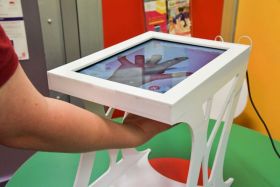An ‘augmented reality’ joint scanner installed at The Children’s Hospital at Westmead, NSW, will be used as an education tool to encourage treatment adherence in young people with haemophilia.
Donated by Sanofi, the device will be used by clinical staff at the hospital’s Paediatric Haematology Unit, to show young patients and their families the possible future impact of haemophilic arthropathy and the importance of maintaining a regular treatment program to help prevent bleeding episodes.
 The scanner works by using a ‘leap motion’ 3D camera attached to a computer to scan and map a person’s hand when placed under the device. Software then overlays imagery onto the user’s hand to replicate normal ageing and the possible impact of joint disease in 10, 20, 30 years in the future both with and without treatment.
The scanner works by using a ‘leap motion’ 3D camera attached to a computer to scan and map a person’s hand when placed under the device. Software then overlays imagery onto the user’s hand to replicate normal ageing and the possible impact of joint disease in 10, 20, 30 years in the future both with and without treatment.
“Pictures often say more than words and this is what I think the scanner will do,” said Robyn Shoemark, Clinical Nurse Consultant in Haematology.
She said treatment for haemophilia was often self-administered at home, with patients and parents being responsible for treatment adherence. And while patients may be aware of the immediate implications of a bleed if treatment is missed, such as bruising and joint swelling, the scanner showed the longer term effects.
“We can talk about the benefits of doing treatment and the consequences of not doing treatment, but what this scanner does is show our patients and their family what this looks like and how this will impact them throughout the life. It makes it much more real.”
“We hope this scanner will help us educate our patients, particularly our teenagers, about why regular treatment is important because even though they may feel fine missing a treatment here or there now, they may be causing themselves long-term damage that will impact their lives in the future,” she added.
While the scanner uses only the user’s hand as its reference point, it also has the ability to expand the replicated view on the screen beyond the hand to see what is happening elsewhere in the body, focusing on specific joints known to be impacted by haemophilia including the shoulder, knee, or ankle.